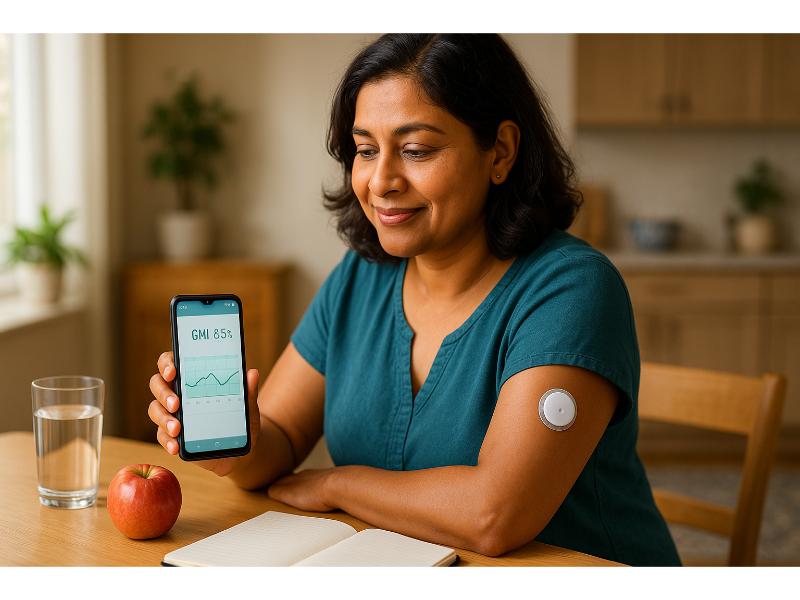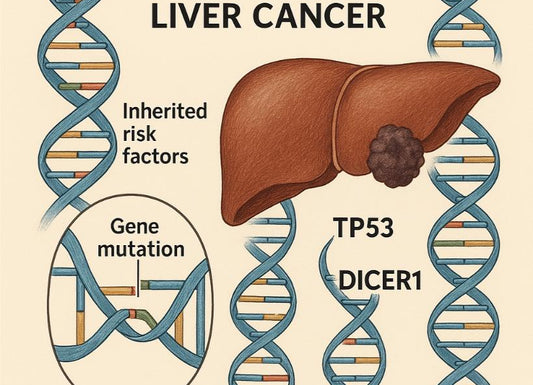Understanding GMI Diabetes: A Smarter Way to Manage Your Blood Sugar
 Written By
Yusela Aquino
Written By
Yusela Aquino

Managing diabetes can feel overwhelming when traditional monitoring methods give you incomplete health information. Glucose Management Indicator (GMI) is a breakthrough approach to diabetes care that provides a clearer, more accurate picture of your blood sugar control. This innovative metric works with your continuous glucose monitor to give you real-time insights that can transform how you manage your condition. Understanding GMI diabetes helps you take a crucial step toward better diabetes management and improved quality of life.
Key Insights
-
GMI shows your daily blood sugar patterns more accurately than traditional A1C tests, especially if you have frequent glucose changes
-
Real-time monitoring lets you adjust diet, exercise, and medication immediately instead of waiting months between lab tests
-
GMI calculations use continuous glucose monitoring data, making them more representative of your actual glucose exposure throughout each day
-
This metric identifies glucose variability patterns that A1C tests often miss, giving you a complete picture of your diabetes management
-
GMI empowers you to take control of your health with actionable data for making informed daily care decisions
What is GMI Diabetes and Why Should You Care?
GMI diabetes management revolutionizes how we understand and monitor blood glucose control. GMI, or glucose monitoring indicator, estimates what your A1c would be based on your continuous glucose monitoring data. This approach gives you a complete picture of your glucose patterns throughout each day and night.
Traditional diabetes monitoring relies on occasional fingerstick tests or quarterly A1C lab work. GMI provides continuous insights into your glucose management instead. The metric uses an average of your glucose readings from a continuous glucose monitor over 14 days. This real-time approach helps you understand how your daily choices affect your blood sugar levels.
GMI matters because it connects your daily glucose experiences with long-term health outcomes. Traditional A1C tests only show your average blood glucose over two to three months without revealing the peaks and valleys that happen throughout each day. GMI reveals these important fluctuations that can significantly impact your health and well-being.
For people living with diabetes, GMI offers hope for better management through personalized, actionable information. You can make adjustments in real-time based on continuous feedback from your glucose monitor instead of waiting months to see if your management strategy works.
Understanding GMI and Its Role in Managing Your Health
GMI works as your personal diabetes dashboard, providing insights that help you make better health decisions every day. The metric uses a specific formula that converts your average glucose readings into an estimated A1C equivalent, giving you familiar reference points while offering detailed information.
Your GMI reading reflects your body's unique glucose patterns and responses to different foods, activities, and stressors. This personalized approach means two people with the same A1C might have very different GMI readings, revealing important differences in their glucose management needs.
GMI shows you immediate cause-and-effect relationships between your choices and glucose levels. When you eat a particular meal, exercise at a certain time, or experience stress, you can see how these factors affect your glucose in real-time instead of guessing about their impact.
GMI also identifies patterns that traditional monitoring methods might miss. You might discover that your glucose spikes at certain times of day, responds differently to specific foods, or fluctuates with your sleep patterns. This information becomes invaluable for fine-tuning your diabetes management approach.
How GMI Helps You Track Your Diabetes Progress?

GMI transforms diabetes monitoring from a reactive approach to a proactive health management strategy. Instead of wondering whether your management plan works, you receive continuous feedback that helps you adjust your approach in real-time.
Continuous GMI monitoring means you can track progress daily instead of waiting for quarterly lab appointments. This immediate feedback loop lets you celebrate small victories and address challenges before they become larger problems. You can see how the following affect your glucose control within days:
-
Exercise routines
-
Medication adjustments
GMI tracking reveals trends and patterns that help you understand your diabetes better. You might notice that your glucose control improves on days when you exercise in the morning, or that certain foods consistently cause spikes regardless of portion size. These insights become powerful tools for personalizing your management strategy.
Progress tracking with GMI improves communication with your healthcare team. Instead of relying on memory or occasional glucose logs, you can share detailed data that shows exactly how your glucose responds to different situations. This information helps your doctor make more informed treatment decisions.
The psychological benefits of GMI tracking are significant for people managing diabetes. Seeing real-time improvements in your glucose control provides motivation and confidence that your efforts make a difference. This positive feedback loop encourages continued engagement with your diabetes management routine.
GMI vs A1C: How GMI Provides a More Accurate Picture of Your Health
GMI offers several advantages over traditional A1C testing for daily glucose management. While A1C provides valuable information about your average glucose over two to three months, it doesn't reveal the glucose variability that significantly impacts your health and quality of life.
A1C testing can be influenced by factors unrelated to your glucose control, including:
-
Anemia
-
Kidney disease
-
Specific medications
On the other hand, GMI, calculated directly from your glucose readings, eliminates these confounding factors and provides a clearer picture of your actual glucose exposure.
GMI captures glucose variability that A1C misses entirely. Two people might have identical A1C values but vastly different glucose patterns. One person might maintain steady glucose levels throughout the day while another experiences frequent highs and lows that average out to the same A1C value. GMI reveals these critical differences.
The timing advantage of GMI proves essential for effective diabetes management. A1C reflects glucose control from several months ago, making it difficult to assess recent changes to your management routine. GMI provides current information that reflects your most recent efforts and adjustments.
GMI accounts for individual differences in how glucose affects different people. Some individuals naturally have higher or lower glucose variability, and GMI captures these personal patterns more accurately than standardized A1C targets.
The Link Between GMI and A1C: What You Need to Know
Understanding the relationship between GMI and A1C helps you use both metrics effectively in your diabetes management strategy. While these measurements are related, they each provide unique insights that contribute to a complete picture of your glucose control.
GMI typically correlates within 0.5% of your laboratory A1C result. This correlation means you can use GMI as a reliable predictor of what your next A1C test might show, allowing you to make adjustments before your next lab appointment.
When GMI and A1C differ, these differences provide valuable information about your glucose management. If your GMI is consistently lower than your A1C, it might indicate that your glucose control has improved recently. Conversely, if GMI is higher than your A1C, it could suggest that your control has declined since your last lab test.
The key difference lies in timing and detail. A1C reflects your average glucose over the past two to three months, with more recent glucose levels having slightly more influence. GMI reflects your glucose patterns over the most recent 14 days, providing a current assessment of your management efforts.
Both metrics serve important roles in comprehensive diabetes care. GMI provides ongoing feedback for daily management decisions, while A1C offers a standardized measure that healthcare providers use to assess long-term glucose control and adjust treatment plans.

How to Use GMI to Make Smarter Diabetes Decisions
GMI empowers you to make informed decisions about your diabetes management by providing real-time feedback on your choices. Instead of guessing about the impact of dietary changes, exercise routines, or medication timing, you can see exactly how these factors affect your glucose control.
-
Start by establishing your baseline GMI reading and tracking how it responds to different situations.
-
Notice patterns in your glucose levels throughout the day
-
Identify foods that cause unexpected spikes
-
Observe how exercise timing affects your overall control
This information becomes the foundation for personalizing your management approach.
Use GMI data to optimize your meal planning and timing. If you notice significant glucose spikes after certain meals, you can experiment with portion sizes, food combinations, or eating schedules to minimize these spikes. GMI shows you the results of these experiments within days.
GMI helps you fine-tune your exercise routine for better glucose control. You might discover that morning workouts provide better all-day glucose stability, or that certain types of exercise are more effective for managing post-meal glucose spikes.
Work with your healthcare team to use GMI data for medication adjustments. Your doctor can use detailed GMI patterns to optimize medication timing, dosages, or types to better match your individual glucose patterns and lifestyle.
Is GMI the Future of Diabetes Management?
GMI represents a significant step forward in personalized diabetes care, offering tools and insights that were impossible with traditional monitoring methods. As continuous glucose monitoring technology becomes more accessible and affordable, GMI-based management strategies are likely to become standard practice for people with diabetes.
The future of diabetes management is moving toward personalized, data-driven approaches that GMI exemplifies. Instead of one-size-fits-all treatment protocols, healthcare providers can use detailed GMI data to create individualized management plans that account for each person's unique glucose patterns and lifestyle factors.
Technology integration will likely make GMI even more powerful in coming years. Smartphone apps already provide GMI calculations and trend analysis, and future developments may include artificial intelligence that can predict glucose patterns and suggest proactive management strategies based on your individual GMI data.
GMI supports the growing emphasis on patient empowerment in healthcare. By providing people with diabetes access to detailed, understandable information about their glucose control, GMI encourages active participation in management decisions and promotes better long-term outcomes.
![]()
Start Monitoring Your Diabetes More Effectively with GMI Now
Beginning your GMI utilization requires a continuous glucose monitor and commitment to using the data it provides. Most modern glucose monitors automatically calculate GMI, making it easy to start tracking this important metric without additional equipment or complicated procedures.
-
Choose a continuous glucose monitor that fits your lifestyle and budget.
Many insurance plans now cover these devices for people with diabetes, making them more accessible than ever. Your healthcare provider can help you select the best option for your specific needs and situation.
-
Establish a routine for reviewing your GMI data regularly.
Most glucose monitoring apps provide daily, weekly, and monthly GMI trends that help you understand your patterns over time. Set aside time each week to review your data and identify areas for improvement.
-
Start small by focusing on one aspect of your diabetes management at a time.
You might begin by using GMI to optimize your breakfast choices, then gradually expand to other meals and activities. This approach prevents overwhelm while building confidence in using GMI data effectively.
-
Connect with your healthcare team about incorporating GMI into your diabetes management plan.
Share your GMI data during appointments and discuss how to use this information to optimize your treatment approach. Many healthcare providers are eager to work with patients who actively monitor their glucose patterns.
Take Control of Your Diabetes with GMI Today
Taking control of your diabetes with GMI starts with understanding that you have more power over your glucose control than you might realize. Every choice you make throughout the day affects your glucose levels, and GMI helps you see these connections clearly for the first time.
-
Commit using GMI data to guide your daily decisions rather than simply collecting information
-
Set realistic goals for improving your GMI over time
-
Build support systems that include your healthcare team, family members, and even other people who have diabetes
Remember that GMI is a tool to support your diabetes management, not a judgment of your worth as a person. Some days will show better glucose control than others, and that's completely normal. Use GMI data to learn and improve rather than criticize yourself for imperfect numbers.

Step-by-Step Guide to Calculating Your GMI
Calculating your GMI requires continuous glucose monitoring data and a simple mathematical formula that converts your average glucose readings into an estimated A1C equivalent. Most glucose monitors and smartphone apps calculate this automatically, but understanding the process helps you interpret your results more effectively.
Step 1:
Gather your continuous glucose monitoring data for at least 14 days. This timeframe provides enough information to calculate a reliable GMI while being recent enough to reflect your current management efforts. Most glucose monitors store this data automatically and make it easily accessible through companion apps.
Step 2:
Calculate your average glucose level over the selected timeframe. This involves adding up all your glucose readings and dividing by the total number of readings. Continuous glucose monitors typically take readings every few minutes, providing hundreds of data points for your calculation.
Step 3:
Apply the GMI formula to convert your average glucose into an estimated A1C percentage. The standard formula is: GMI = 3.31 + (0.02392 × average glucose in mg/dL). For glucose measured in mmol/L, the formula is: GMI = 3.31 + (0.02392 × average glucose × 18.018).
Step 4:
Compare your calculated GMI to your most recent A1C test to understand how well the metrics align. Small differences are normal and expected, but large discrepancies might indicate changes in your glucose control or factors affecting your A1C accuracy.
Step 5:
Track your GMI trends over time rather than focusing on individual daily calculations. Weekly and monthly GMI averages provide more meaningful insights into your overall glucose management patterns and progress.
Along with monitoring the patterns in GMI, you may also use at-home urine test kits, which can determine whether glucose has leaked over your urine. This may suggest that your blood glucose level has exceeded kidney threshold of about 180 mg/dL.
Quick Summary Box
-
GMI provides real-time insights into your diabetes management that traditional A1C testing cannot match, giving you immediate feedback on your daily choices
-
Continuous glucose monitoring data forms the foundation of GMI calculations, making this metric more representative of your actual glucose exposure than periodic lab tests
-
GMI identifies glucose variability patterns that significantly impact your health but often go undetected with traditional monitoring methods
-
The metric empowers proactive diabetes management by showing you cause-and-effect relationships between your choices and glucose levels within days
-
GMI represents the future of personalized diabetes care, offering tools for individualized management strategies based on your unique glucose patterns and responses
References
Bergenstal, R. M. (2018). Understanding Continuous Glucose Monitoring Data. PubMed; American Diabetes Association. https://www.ncbi.nlm.nih.gov/books/NBK538967/
Bergenstal, R. M., Beck, R. W., Close, K. L., Grunberger, G., Sacks, D. B., Kowalski, A., Brown, A. S., Heinemann, L., Aleppo, G., Ryan, D. B., Riddlesworth, T. D., & Cefalu, W. T. (2018). Glucose Management Indicator (GMI): A New Term for Estimating A1C From Continuous Glucose Monitoring. Diabetes Care, 41(11), 2275–2280. https://doi.org/10.2337/dc18-1581
CDC. (2024, May 15). Testing for Diabetes and Prediabetes: A1C. Diabetes. https://www.cdc.gov/diabetes/diabetes-testing/prediabetes-a1c-test.html
Grossman, J., Ward, A., Crandell, J. L., Prahalad, P., Maahs, D. M., & Scheinker, D. (2021). Improved individual and population-level HbA1c estimation using CGM data and patient characteristics. Journal of Diabetes and Its Complications, 35(8), 107950. https://doi.org/10.1016/j.jdiacomp.2021.107950
Hieshima, K., Sugiyama, S., Yoshida, A., Kurinami, N., Suzuki, T., Ijima, H., Miyamoto, F., Kajiwara, K., Jinnouchi, K., Jinnouchi, T., & Jinnouchi, H. (2020). Elevation of the renal threshold for glucose is associated with insulin resistance and higher glycated hemoglobin levels. Journal of Diabetes Investigation, 11(3), 617–625. https://doi.org/10.1111/jdi.13191
Łukasz Wybrańczyk, Aleksandra Brudzińska, Przemysława Jarosz-Chobot, & Deja, G. (2023). Glucose management indicator – potential factors affecting differences in comparison with HbA1c and clinical significance of this phenomenon. Pediatric Endocrinology, Diabetes, and Metabolism, 29(3), 190–195. https://doi.org/10.5114/pedm.2023.130028
Morris-Murray, M., & Frazzitta, M. (2024). Using continuous glucose monitoring to measure and improve quality metrics: Updates on the Healthcare Effectiveness Data and Information Set 2024 Glucose Management Indicator measure. Journal of Managed Care & Specialty Pharmacy, 30(10-b Suppl), S30–S39. https://doi.org/10.18553/jmcp.2024.30.10-b.s30

Author information not available.



